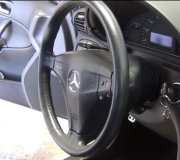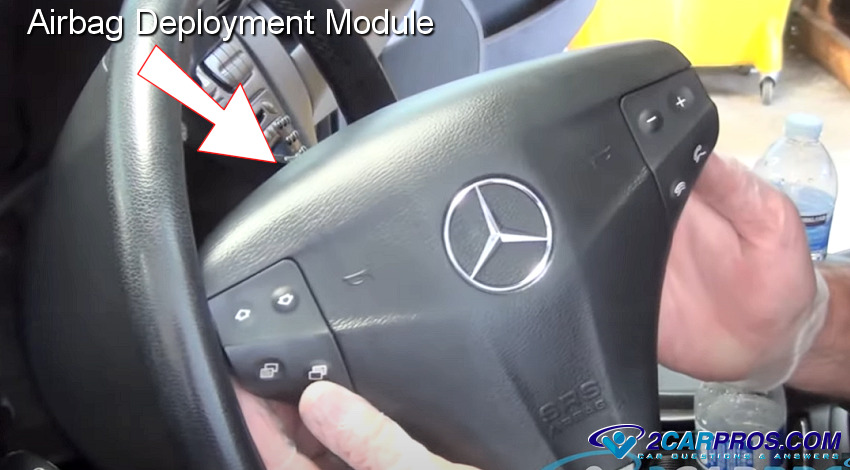This one's easy. Just don't drive over 50 mph!
If you insist on driving faster, there are a number of things to look at. I'm guessing these first things have been done, but to be safe; switch the front wheels / tires to the rear, then see if the vibration is still in the steering wheel or if you only feel it in the seat. If the symptoms have changed, it's due to a tire or wheel. By the way, did this problem only start after the new tires were installed or was it there before and you bought the new tires to try to solve it?
If it's looking like a tire or wheel is the cause, most shops are using "road force" wheel balancers now. Those will detect problems that plain balancing won't solve. It can be as simple as spinning the tire on the wheel a little. Wheels don't have to be sent out for inspection. They can be checked on the balancer with a dial indicator. Remove the tire, then install the wheel on the balancer. Use the dial indicator to measure the run-out in four places. Those are vertically and horizontally along both sides where the tire's beads seat on the lips of the wheel. Unless specified differently by the manufacturer, .045" is the maximum allowed for light pickup trucks. I don't know if there is a spec. For cars, so look for something that is radically different on one of the wheels. Being the only driver is not a valid observation because wheels can be bent on older-style tire changers very easily. That was possible in the 1980s when I worked at a Sears Auto Center, and wheels have only gotten lighter and cheaper since then. Hitting a bunch of potholes will do wheels in too. Typically if a wheel is bent because you hit something, it's too bent to drive the car with it.
You mentioned static balancing too. That is not an accepted practice anymore. It was okay in the days when that's all there was because cars and wheels were much heavier and a little wheel imbalance wasn't an issue. Imagine if you had a perfectly in-balance wheel / tire assembly on the left front of the car. Now add a 1-ounce weight at the top of the wheel on the outer edge, and another 1-ounce weight at the bottom on the inner edge. That wheel would still be in perfect balance on the bubble balancer, but on the car, centrifugal force would make those two weights want to spin in the same plane which would set up a horrendous wobble and tugging on the steering linkage. The electronic spin balancer finds those two 1-ounce weights and will show to add a pair across the wheel from each of those. That will bring the wheel into dynamic balance and won't affect the static balance.
Also keep in mind that if you add a 1-ounce weight in one spot, you can counteract that with a 2-ounce weight on the same side of the wheel, but half as far from the center. That will show up as a perfectly-balanced wheel on the bubble balancer, AND on the spin balancer, ... But only at one specific speed. To say this a different way, if you spin just the wheel with no tire on the balancer and it comes up saying one ounce is needed in one spot, obviously something is causing that imbalance. It might be a heavy spot, but it is more likely to be a light spot, and what caused that? Is a spot rusted away? Is there a welding bead from when the wheel was manufactured? Don't know; don't care, but what if that light spot is only half way out from the center? A weight added to the lip will add to the light spot, but the wheel will only be in balance at that one speed the balancer spins the assembly at. At any faster speed, the outer weight has much more centrifugal force and much more affect on the balance.
If the run-out is good on the balancer, mount the wheel on the car, then do the same measurement on one side of the wheel. You should get the same reading you got on the balancer. Most commonly this is where the excessive run-out will show up, and it's real common on GM cars. The wheel bearing assembly has three access holes in it for a socket to fit through. Water will splash up there and get on the backside of the rotor where it forms three corresponding spots of rust. When a professional does a brake job, he either replaces the rotor or he machines the old one, and if he machines it, the first step is to scrape off those spots of rust. If they aren't removed, they can cause the rotor to not sit squarely on the brake lathe, and a warp will be machined into it. THAT warp, if bad enough, will cause the brake caliper to slide back and forth once per wheel revolution, and that mass can tug on the steering linkage and be felt in the steering wheel. The clue is you'll only feel that at higher speeds, and it usually gets worse when the brakes are applied lightly. The additional clue is the wheel will not show excessive run-out when checked on the car. Often you can actually see the caliper sliding back and forth when running the engine in gear on a hoist. The rotor has to be bolted tight with at least two lug nuts.
Along with those rust spots, all rotors develop a ring of rust just outside of the outer circumference of the hub. Usually the mounting cone for the brake lathe doesn't sit on that rust, but to be safe, professionals scrape that off too. If it isn't removed, a chunk of that rust can break off and get stuck between the rotor and hub when the rotor is reinstalled.
The most common cause of this vibration when a do-it-yourselfer does a brake job is he doesn't address those rust spots at all. If the rotor is removed, then reinstalled in a different orientation, that rust is caught between the rotor and the hub. That prevents the rotor from sitting squarely on the hub. This will show up with the dial indicator measuring just the rotor, but unlike in the last paragraph, this WILL cause excessive run-out to show up on the wheel, but only on the car, not on the balancer. The wheel sits squarely against the rotor but the rotor is not sitting squarely on the hub.
Also look at the center area of the inside of the wheels. Sometimes debris gets caught between the wheel and the rotor and prevents the wheel from sitting squarely. This is a real big problem with cast wheels because they corrode quickly and chunks will break off. You may not see the excessive run-out on the balancer because the mounting contact points are often different than where the wheel touches the hub on the car. One clue here is you'll usually see some steering wheel oscillation while driving very slowly, as in through a parking lot. The same is true for a broken tire belt, but that shouldn't be an issue with new tires.
If you have cast wheels, there's a lot more that can cause problems than with standard steel wheels. One problem in particular is corrosion around the center hole. Logic dictates if that hole is no longer round, the wheel can be bolted on off-center, but the lug nuts' friction surfaces will set the wheel in the right place. What you might find though is that corroded material has become impacted to the hub right around the center hole of the rotor. If you have five wheel studs, there are five ways the wheel can be installed, and only one of those MIGHT still allow the wheel to sit squarely on the hub. There's an eighty percent chance the wheel gets installed differently and some of that debris prevents the wheel from sitting squarely against the rotor. The same thing can happen at the rotor's center hole, but it's much less common.
Check how many weights have been added to the wheels. If you find two on one side of one wheel, the balancer picked up the larger first imbalance, then when rechecked, it found a second imbalance. That second weight should be considerably smaller than the first one. If you find three weights spaces equally around the wheel, the balancer is out of calibration or there's a bad bearing on its shaft. All balancers have a calibration procedure that rarely takes longer than one or two minutes. When you find three weights, you'll almost always find three weights on both sides of every wheel.
Part of installing new tires should include "reading" the wear patterns of the old tires, and inspecting the steering and suspension system parts. In particular, worn ball joints, tie rod ends, and struts can allow a wheel to oscillate back and forth and show up as a steering wheel shimmy. The unacceptable movement between a ball and socket of a ball joint or tie rod end is sideways which allows parts to shift and let the wheel shift back and forth. Vertical movement is usually also unacceptable, (it's normal on a few models), but will only cause clunking noises, not changes in alignment or the accompanying steering wheel shimmy. Struts can wear internally and allow the car to bounce excessively, but it isn't until they get real bad and the shaft can wobble back and forth where it comes out the top of the strut body that you'll have more symptoms. Your mechanic would have seen the oil leaked out or you would have noticed a real lot of clunking long before the shimmy showed up.
There's one more thing we can discuss that only applies to GM front-wheel-drive cars that have had the front cross member lowered to work on the engine or transmission. The problem and symptoms are much more severe than what you described so we'll skip that for now.
SPONSORED LINKS
Friday, September 9th, 2016 AT 8:32 PM



